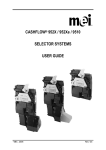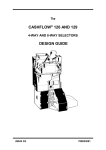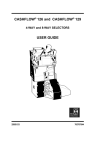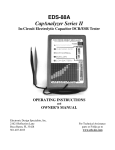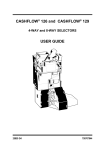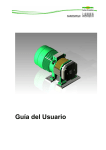Download Mars CASHFLOW 126 Product specifications
Transcript
CASHFLOW® 9520 / 9524 / 9528 SELECTOR SYSTEMS DESIGN GUIDE MEI., 2003 Rev: G1 CashFlow® 9520 / 9524 / 9528 Design Guide PUBLISHED BY: MEI CashFlow® 9520 / 9524 / 9528 Design Guide Eskdale Road Winnersh Triangle Wokingham Berkshire RG41 5AQ United Kingdom. Internet: http://www.meiglobal.com For further information on editions in other languages please contact the Technical Communications Manager at the above address. ® CashFlow 9520 / 9524 / 9528 Selector Design Guide © , Mars, Inc., 2003. All rights reserved Except as permitted under the relevant local legislation, no part of this publication may be copied, transmitted, transcribed, or distributed in any form or by any means, or stored in a database or retrieval system, or translated in any language (natural or computer), without the prior written permission of MEI. ® ® Mars , CashFlow and the MEI device are registered trademarks. MEI reserves the right to change the product or the product specifications at any time. While every effort has been made to ensure that the information in this publication is accurate, MEI disclaims any liability for any direct or indirect losses (howsoever caused) arising out of use or reliance on this information. This document does not necessarily imply product availability. This edition (March 2003) Printed in the United Kingdom. Note: Your product may differ slightly from some of the illustrations in this document. © MEI., 2003 Page 2 Rev: G1 CashFlow® 9520 / 9524 / 9528 Design Guide CONTENTS SAFETY.................................................................................................................................................................5 WARNING ............................................................................................................................................................5 CAUTION .............................................................................................................................................................5 MAXIMUM OPERATING VOLTAGE ........................................................................................................................5 DANGEROUS ENVIRONMENTS ..............................................................................................................................5 DISPOSAL OF PRODUCT........................................................................................................................................5 CONFORMANCE TO INTERNATIONAL STANDARDS................................................................................................5 PRODUCT IDENTIFICATION ..........................................................................................................................6 PRODUCT OPTIONS; FRONT PLATES ....................................................................................................................7 PRODUCT OPTIONS; REJECT COVERS ..................................................................................................................8 PRODUCT BUILD OPTIONS ...................................................................................................................................9 DESCRIPTION & OPERATION......................................................................................................................11 COIN ENTRY (1) ................................................................................................................................................12 DIAGNOSTIC ‘BI-COLOUR’ LED (2) ..................................................................................................................12 I-BUTTON MEMORY CONTACTS (3) ...................................................................................................................12 SUPPORT TOOL CONNECTOR (CPM) (4)............................................................................................................12 ROUTE INHIBIT CONNECTOR (5) ........................................................................................................................12 SERIAL INTERFACE CONNECTOR (HII) (6).........................................................................................................12 SEPARATOR CONNECTOR (7),............................................................................................................................12 8 WAY DIP SWITCH (8) .....................................................................................................................................12 POST-GATE STROBES (9)...................................................................................................................................13 DUAL POLARITY AND BCO INTERFACE CONNECTOR (10).................................................................................13 PRE-GATE STROBES (11)...................................................................................................................................13 VALIDATOR LID (12) .........................................................................................................................................13 PRODUCT INTERFACES ................................................................................................................................14 STANDARD INTERFACES ....................................................................................................................................14 PARALLEL MODE ...............................................................................................................................................14 MULTI-PULSE ....................................................................................................................................................14 COIN VALIDATION INHIBITS A, B, C, D, E, F.....................................................................................................14 PARALLEL OUTPUT MODE INHIBITS....................................................................................................................14 COIN OUTPUT COMMON LINE............................................................................................................................14 BINARY CODED OUTPUT (BCO) - UK...............................................................................................................15 BINARY CODED OUTPUT (BCO) - EURO ...........................................................................................................15 COIN VALIDATION INHIBITS A, B, C, D, E, F ....................................................................................................17 BINARY CODED OUTPUT MODE INHIBITS - UK .................................................................................................17 BINARY CODED OUTPUT MODE INHIBITS - EURO ..............................................................................................17 AUTOMATIC MODE - PARALLEL OR BCO SELECTION........................................................................................18 MECHANICAL ....................................................................................................................................................18 ELECTRICAL INTERFACES..........................................................................................................................19 INTRODUCTION ..................................................................................................................................................19 CONNECTOR 1, MACHINE INTERFACE. ..............................................................................................................19 SEPARATOR CONNECTOR (2) .............................................................................................................................20 ROUTE INPUT LINES - ROUTES 1-7 ....................................................................................................................20 MACHINE INTERFACE CONNECTOR (CONNECTOR 1) ..........................................................................................21 DYNAMIC ROUTE INHIBIT (CONNECTOR 4) ........................................................................................................21 SUPPORT TOOL CONNECTOR (6-WAY) ...............................................................................................................22 SERIAL (HI2) CONNECTOR (10 - WAY)...............................................................................................................22 ROUTING CONFIGURATION ........................................................................................................................23 COIN ROUTING PRIORITY ...................................................................................................................................23 CONNECTOR 4, DYNAMIC ROUTE INHIBIT .........................................................................................................24 © MEI., 2003 Page 3 Rev: G1 CashFlow® 9520 / 9524 / 9528 Design Guide Y-CHUTE INTERFACE CONNECTOR ....................................................................................................................25 DUAL ENTRY SYSTEM .......................................................................................................................................26 ELECTRICAL SPECIFICATION....................................................................................................................27 COIN OUTPUT ELECTRICAL SPECIFICATION .......................................................................................................27 ABSOLUTE MAXIMUM RATINGS ........................................................................................................................27 OUTPUT COMMON SPECIFICATION .....................................................................................................................28 POSITIVE COMMON VOLTAGE RANGE ...............................................................................................................30 NEGATIVE COMMON VOLTAGE RANGE .............................................................................................................31 NEGATIVE COMMON OUTPUTS:.........................................................................................................................31 BINARY CODED OUTPUT (BCO)........................................................................................................................31 COIN INHIBITS ...................................................................................................................................................31 MECHANICAL INTERFACE DRAWINGS ...................................................................................................32 CF9524 FRONT PLATE DIMENSIONS..................................................................................................................32 CF9524 TOP ENTRY MOUNTING SPACE ENVELOPE ..........................................................................................32 CF9528 LONG CHANNEL MOUNTING SPACE ENVELOPE ...................................................................................32 COMPATIBILITY .............................................................................................................................................40 PERFORMANCE STANDARDS......................................................................................................................41 POWER SUPPLY .................................................................................................................................................41 COMPLIANCE CLASSIFICATIONS .........................................................................................................................41 FLAMMABILITY..................................................................................................................................................41 POWER SUPPLY INPUT PROTECTION ..................................................................................................................42 MECHANICAL PARTS .........................................................................................................................................42 COIN SIZES ........................................................................................................................................................42 COIN ACCEPTANCE RATE ..................................................................................................................................42 ENVIRONMENTAL PERFORMANCE ..........................................................................................................43 TEMPERATURE RANGE ......................................................................................................................................43 HUMIDITY RANGE .............................................................................................................................................43 TEMPERATURE / HUMIDITY SPECIFICATION .......................................................................................................43 THERMAL SHOCK...............................................................................................................................................44 TRANSPORTATION .........................................................................................................................................45 PRODUCT SUPPORT .......................................................................................................................................46 © MEI., 2003 Page 4 Rev: G1 CashFlow® 9520 / 9524 / 9528 Design Guide SAFETY Warning Before cleaning, servicing, removing or replacing CashFlow® units ALWAYS SWITCH OFF or ISOLATE the ELECTRICITY SUPPLY to the host machine. Caution This guide is recommended for use by personnel trained to carry out electrical installation. Maximum Operating Voltage Do not apply more than the voltage specified on the unit, and within the following: Full Operating Voltage range: +10V to +15V DC (+12V nominal) Supply Voltage Ripple: Within Vmin to Vmax up to 100Hz, <250mV pk - pk for Frequency>100Hz Current consumption: • Quiescent current: 100mA Max • Max current: 3A Max ® (4 solenoids active, Cashflow 9524) Dangerous Environments Do not operate the unit in the presence of flammable gasses or fumes, or after the entry of fluid into the machine. Disposal of Product Always dispose of defective units according to local regulations. Conformance to International Standards When installed and operated according to the instructions provided for the particular unit, ® CashFlow products meet the applicable international and national safety standards for any country in which they are used. SAFETY All electrical connections to the product must be rated according to the requirements for “Accessible SELV” circuits as defined in EN60335-1. The product is therefore suitable for use in a class 2 (non-earthed or non-grounded) appliance. Overcurrent protection is not included in the product and should be provided as part of the host machine. The recommended fuse value at the rated supply of 12V is: 3A Slow blow (to EN60127) Other protection methods may be used providing their overcurrent characteristics remain within the overall operating characteristics of the above fuse. Warning: This is a class A product. In a domestic environment this product may cause radio interference, in which case the user may be required to take adequate measures. © MEI., 2003 Page 5 Rev: G1 CashFlow® 9520 / 9524 / 9528 Design Guide PRODUCT IDENTIFICATION MEI has manufactured coin mechanisms compatible with gaming and amusement machines for a number of years. Over this time the functionality of the range has been enhanced to match the market needs and whilst maintaining mechanical compatibility. The products detailed in this handbook relate to the CashFlow® 952x Series. To ensure you have the right product for your application please read this section. ® • • • • • © CashFlow 9520 Supports 4 way Separator (optional) Supports 8 way Separator (optional) Available as Side Entry or Top Entry CashFlow® 9524 ® Comprising of CashFlow 9520 plus 4 way Separator, available as Side Entry, Top Entry or System Product MEI., 2003 Page 6 ® • • CashFlow 9528 ® Comprising of CashFlow 9520 plus 8 way Separator, available as Top Entry or System Product Rev: G1 CashFlow® 9520 / 9524 / 9528 Design Guide Product Options; Front Plates Coin Entry Bezel Reject Button Coin Reject Exit Coin Catcher Hoop 7802 This model has a brushed stainless steel front plate suitable for external surface mounting. It is supplied complete with a coin catcher hoop, a coin entry bezel and a coin mechanism mounting plate assembly. © MEI., 2003 7804 7805 7819 This front plate is made of mild steel painted black and is a standard assembly suitable for internal mounting. This model consists of the same parts as the 7804 except that the black mild steel front plate is wider and slightly shorter. This is the basic coin mechanism mounting plate assembly made from clear polycarbonate. It is supplied with the standard coin entry bezel assembly. It is not supplied with a coin catcher hoop. Page 7 Rev: G1 CashFlow® 9520 / 9524 / 9528 Design Guide Product Options; Reject Covers Reject Cover C B A C Type Coins Rejected Exit Accepted Coin Path B Type Coins Rejected Exit Type A Used with: Type B A Type Coins Rejected Exit Type C ® Used with: CashFlow 9520 ® Used with: ® CashFlow 9520 CashFlow 9520 CashFlow® 9524 CashFlow® 9524 ® CashFlow 9528 This type of reject cover is used on validators that are fitted with separators. This type of reject cover is used on validators that are fitted to small channels. This type of reject cover is used on validators that are fitted to front plates. Accept coins are routed to the right and down. Accepted coins are routed to the right and down. Accepted coins are routed to the right and down. Rejected coins are routed to the bottom centre of the reject cover. Rejected coins are routed to the bottom left of the reject cover. Rejected coins are routed to the left-hand side of the reject cover. © MEI., 2003 Page 8 Rev: G1 CashFlow® 9520 / 9524 / 9528 Design Guide Product Build Options Each product variant is made from the following components: Side Entry Product 7802 Front Plate Side Entry Validator 7804 Front Plate 7805 Front Plate CF9524 4-way Separator 7819 Front Plate © MEI., 2003 Page 9 Rev: G1 CashFlow® 9520 / 9524 / 9528 Design Guide Top Entry Product Coin Entry/Token Entry Bezel (with electrics) CF9524/8 Y-Chute CF9524/8 Top Entry Validator Metal Channel CF9528 Short Channel (Supplied by machine manufacturer Manifold 4-way Separator 8-way Separator Tube Collar Plate © MEI., 2003 Page 10 Rev: G1 CashFlow® 9520 / 9524 / 9528 Design Guide DESCRIPTION & OPERATION 13 1 12 2 i™Button Memory 3 11 4 10 5 9 6 7 8 Key: 1 Coin Entry 2 Diagnostic ‘Bi-Colour’ LED 3 i-Button Memory Contacts 4 Support Tool Connector (CPM) CashFlow® Programming Module 5 Route Inhibit Connector 6 Serial Interface Connector (HII) 7 Separator Connector 8 8-way DIP Switch 9 Post Gate Strobes 10 Dual Polarity and BCO Interface Connector 11 Pre-Gate Strobes 12 Validator Lid 13 Reject Lever © MEI., 2003 Page 11 Rev: G1 CashFlow® 9520 / 9524 / 9528 Design Guide Coin Entry (1) There are two types of coin entry available. Top entry and Side entry. • Top entry: The validator is mounted into the Channel and Coins enter through to top of the validator. • Side Entry: The validator is mounted onto the front plate and coins enter through the side of the validator. Diagnostic ‘Bi-Colour’ LED (2) The bi-colour LED displays a sequence of flash codes to indicate the current operation status of the validator, and can be used for fault diagnosis when inserting a coin or when in teaching functions. Flash Code Sequence: Description: Constantly ON Validator power on. 1 Flash Coin accepted / Reject lever pressed. 2 Flashes Coin not recognised and rejected. 3 Flashes Coin rejected by validator. 4 Flashes Coin recognised but not accepted (due to inhibit setting). i-Button Memory Contacts (3) This connector enables the i-button to communicate with the product. i-button activity is indicated by the illumination status of the LED. Support Tool Connector (CPM) (4) ® This 6-way connector is used for a MEI Support Tools, such as the CPM (CashFlow programming Module). Route Inhibit Connector (5) This is a 9-pin connector that provides input from the machine to the validator. Its function is to modify coin routing. When a specific exit is full, the host machine will signal to the validator to redirect subsequent coins to an overflow route. Serial Interface Connector (HII) (6) This 10-pin connector provides a serial interface to an HII interface. Separator Connector (7), This connector is used to connect the validator to the separator. 8 Way DIP switch (8) This switch is used as an easy configuration tool for the product. The 8-way switch can be used to change common settings such as enabling/inhibiting coins and setting coin routing. © MEI., 2003 Page 12 Rev: G1 CashFlow® 9520 / 9524 / 9528 Design Guide Post-Gate Strobes (9) The strobes are used to detect the direction & presence of coins passing through the validator. Dual Polarity and BCO Interface Connector (10) When in NON SERIAL mode, this interface is used to connect to the host machine. The functions provided are: • Coin outputs A, B, C, D, E, F. • Coin inhibits A, B, C, D, E, F. • Coin common output • Output mode selection The acceptor will operate in one of two Coin Output modes: • Parallel - can be positive or negative common • Binary Coded Output (BCO) These will be automatically selected by the “Output mode select” line, if nothing is connected to the output line then the acceptor will default to parallel mode. Pre-Gate Strobes (11) This is an integral part of the validator which detects obstructions around the accept gate. If an obstruction is detected then coin acceptance is inhibited. Validator Lid (12) This lid opens outwards when the reject lever is pressed. It allows for clearance of coins jams and also provides access for cleaning the coin entry paths. It is also used in some product configuration modes. Reject Lever (13) This lever can be pressed to clear any coins that might have got stuck inside the validator lid. © MEI., 2003 Page 13 Rev: G1 CashFlow® 9520 / 9524 / 9528 Design Guide PRODUCT INTERFACES Standard Interfaces The standard interfaces available on CashFlow® 9520/9524/9528 validators are Parallel and Binary Coded Output (B.C.O.). The validator is supplied in Automatic Mode which senses the type of interface selected by the host machine via pin 8 (Output Mode Select) of the machine interface connector. Parallel Mode This type of interface is a standard 6 coin parallel output interface as used in the ME126/129 products (Dual Polarity). The coin outputs for A and C can be combined (e.g. A + C, B, D, E, F) to give compatibility with ME126 validators and can be set by programming the validator. The coin outputs are factory defined. If an alarm condition occurs all coin outputs will be activated simultaneously for >600ms. Multi-Pulse This will only operate when in parallel mode. This factory set option will pulse the GB 50p coin output (of a GB profile) four times on validation of a GB £2 coin. Coin validation Inhibits A, B, C, D, E, F To inhibit coin acceptance the CashFlow® validator offers six individual inhibit inputs. These inhibits operate differently for each mode as detailed in the following section. Parallel Output mode inhibits The channels that activate the associated coin output will be inhibited when the inhibit is held High or no connection is made to the relevant input, (e.g. Inhibit A will inhibit coin output A channels). Coin Output Common Line This line allows for operation with positive or negative common systems. The interface selfconfigures by sensing the output common voltage supplied by the machine on the coin output common line, (pin 2 for a 15 way machine interface connector, or pin 3 for a 17 way connector). All potentials are relative to the 0V return line to the machine. (Pin 11 for a 15-way connector and pin 12 for a 17-way machine interface connector). Negative common operation is selected when pin 2 output common is between 0V to +1.0V. Positive common is selected when pin 2 is greater than +7.0 volts (Max 12V) with respect to pin 11. © MEI., 2003 Page 14 Rev: G1 CashFlow® 9520 / 9524 / 9528 Design Guide Binary Coded Output (BCO) - UK Defined by the validator coin output map. When in BCO mode coin output A is permanently set active to indicate to the host machine that the BCO feature is set. Coin output A will have a high impedance (approx. 1M Ohm to 0v) if coin output common is allowed to float. If an alarm condition occurs, coin outputs B, D, E and F will be activated. (BCO - UK) Coin Output Enabled Outputs Coins A B C D E F 5p 1 0 1 0 0 0 10p 1 1 1 1 0 0 20p 1 0 1 0 1 1 50p (Old) 1 1 1 0 0 1 50p (New) 1 0 1 1 0 1 £1 (1983) 1 1 1 0 1 0 £2 1 1 1 1 1 1 Token 1 0 1 1 1 0 1 1 0 1 1 1 Alarm Output Binary Coded Output (BCO) - Euro Gaming The BCO codes operate in a similar way to those used in the UK. Coin output A is active to indicate to the machine that the Acceptor is in BCO Mode. Coin output C is active when a correct code is given to the machine. This effectively becomes the check used by the machine to authenticate that a current shown code is correct. If this value is not active then the machine will ignore the codes. B, D, E and F become the 4 code states indicating which coin is accepted. © MEI., 2003 Page 15 Rev: G1 CashFlow® 9520 / 9524 / 9528 Design Guide (BCO - EURO) Coin Output Coin No. Value A B C D E F Coin 1 Token 1 1 0 1 0 0 0 Coin 2 Token 2 1 0 1 0 0 1 Coin 3 1c 1 0 1 0 1 0 Coin 4 2c 1 0 1 0 1 1 Coin 5 5c 1 0 1 1 0 0 Coin 6 10c 1 0 1 1 0 1 Coin 7 20c 1 0 1 1 1 0 Coin 8 50c 1 0 1 1 1 1 Coin 9 1Eu 1 1 1 0 0 0 Coin 10 2EU 1 1 1 0 0 1 Coin 11 5Eu 1 1 1 0 1 0 Vending The BCO codes operate in a similar way to those used in Italy. Coin output A is active to indicate to the machine that the Acceptor is in BCO Mode. Coin output E is active when a correct code is given to the machine. This effectively becomes the Parity used by the machine to authenticate that a current shown code is correct. This should be used in Even Parity. Coin outputs B, C, E and D become the 4 code states indicating which coin is accepted. (BCO - EURO) Coin Output Coin No. © Value A B C F D E Coin 1 1c 1 1 0 0 0 1 Coin 2 2c 1 0 1 0 0 1 Coin 3 5c 1 1 1 0 0 0 Coin 4 10c 1 0 0 1 0 1 Coin 5 20c 1 1 0 1 0 0 Coin 6 50c 1 0 1 1 0 0 Coin 7 1Eu 1 1 1 1 0 1 Coin 8 2EU 1 0 0 0 1 1 Coin 9 5Eu 1 1 0 0 1 0 MEI., 2003 Page 16 Rev: G1 CashFlow® 9520 / 9524 / 9528 Design Guide Coin Validation Inhibits A, B, C, D, E, F To inhibit coin acceptance the CashFlow® validator offers six individual inhibit inputs. These inhibits operate for each mode as detailed in the following text. Binary Coded Output Mode Inhibits - UK The channels inhibited, for a given inhibit line becoming active are factory set by the validator coin inhibit map option. When inhibit (A to F) is active, then coins for the channels specified in the map will be inhibited. The default settings for the GB profile are: Inhibit Line Coins inhibited A £2 B Token C Reserved D 20p E 5p, 10p, 50p old & new F £1 Binary Coded Output Mode Inhibits - Euro (BCO - EURO) Coin Inhibit Coin No. Value A B C Coin 1 Token 1 1 X Coin 2 Token 2 1 X Coin 3 1c 1* X Coin 4 2c 1* X Coin 5 5c 1* X Coin 6 10c 1* X Coin 7 20c 1* X Coin 8 50c X Coin 9 1Eu X Coin 10 2EU X Coin 11 5Eu 1* D E F 1 1 1 X X= RESERVED *= GROUPED INHIBIT INPUT © MEI., 2003 Page 17 Rev: G1 CashFlow® 9520 / 9524 / 9528 Design Guide Automatic Mode - Parallel or BCO Selection In this mode the status of the output mode input (on pin 8 of the 17-way connector, or pin 7 for the 15 -way connector of the machine interface) selects either the parallel or the binary coded output interface standards. A logic high signal to this pin will select parallel mode, setting pin 8 to a logic low will select BCO mode. If there is no connection made to pin 8 the interface will default to parallel mode. Mechanical Interface connections are via a 17-way header from the standard PCB. This header is single row of 17 pins on a 0.1 inch x 0.1-inch grid, with a pin size of 0.025-inch square. The complete interface connector (connector 1) functions are shown on the next page. © MEI., 2003 Page 18 Rev: G1 CashFlow® 9520 / 9524 / 9528 Design Guide ELECTRICAL INTERFACES Introduction This section gives the pin assignments for all connector interfaces used on the CashFlow® validators and it also includes timing diagrams of the signals appearing on the input and output lines. Connector 1, Machine Interface. The interface to the validator from the machine is exactly the same as those that apply to the MS/ME series validators, with the exception of pin 8 of the 17-way connector. Connector 1 can accept either 15 pin or 17 pin interface connectors. 17 Way 15 Way Connector Connector Functions (Dual Polarity) GB Input or PIN Coins Output No. BCO Function Definition 1 - A Coin Output 5p O 1 Ident signal 2 1 B Coin Output Token O 2 Accept Output 5 3 2 Coin Output Common I 3 Accept Output Common 4 3 F Coin Output O 4 Accept Output 1 5 4 Polarising Key 1 - 5 Polarising Key 6 5 E Coin Output O 6 Accept Output 2 7 6 D Coin Output O 7 Accept Output 3 8 7 Output Mode Select I 8 Select Line (Output mode) 9 8 C Coin Output O 9 Accept Output 4 10 9 C Coin Inhibit I 10 Inhibit 4 11 10 +12V Supply I 11 +12V Supply 12 11 0V Supply I 12 0V Supply 13 12 D Coin Inhibit I 13 Inhibit 3 14 13 E Coin Inhibit I 14 Inhibit 2 15 14 F Coin Inhibit I 15 Inhibit 1 16 15 B Coin Inhibit I 16 Inhibit 5 17 - A Coin Inhibit I 17 Inhibit 6 £1 50p (£2=x4) 20p 10p Connector types used:- 15 Way Molex SIL 6471 or 17 Way Molex SIL 6471. © MEI., 2003 Page 19 Rev: G1 CashFlow® 9520 / 9524 / 9528 Design Guide Separator Connector (2) This connector is used for connection to the CashFlow® 9524 4-way or CashFlow® 9528 8way separators only. This is identified by a grey panel on the separator. Connector type used:- 20 way Molex DIL 901-42-0020. WARNING: Do not connect ME129, ME126 Active or ME126 Security separators to this product or damage may result. This is identified by a panel that has the facility to fit a route plug into the separator. Route Input Lines - Routes 1-7 The CF9528 exit routes are marked as Route (1, 2, 3, 4, 5, 6 & 7) with (8) being the default exit route, as standard. Routes 1-7 on CF9528 refer to the coin routes 1 to 7, with 1 having high priority and 7 low priority. Routes 1-7 on CF9524 refer to the 4 coin route outputs A, B, C and D as shown in the following table. Note: (d) is the same route as D but has a higher priority. The CF9528 exit routes are marked as Route (1, 2, 3, 4, 5, 6 & 7) with (8) being the default exit route. © Solenoid 3 Solenoid 2 Solenoid 1 9528 Route 9524 Route 1 1 0 1 (d) 1 1 1 2 (c) 1 0 0 3 (a) 1 0 1 4 (b) 0 1 1 5 C 0 1 0 6 D 0 0 1 7 B 0 0 0 8 A MEI., 2003 Page 20 Rev: G1 CashFlow® 9520 / 9524 / 9528 Design Guide Machine interface connector (Connector 1) Interface connections are via a 17-way header from the standard PCB. This header is a single row of 17 pins on a 0.1 inch grid. The pin size is 0.025 inch square. Figure 1 shows the interface connector and pin out Figure 1 2 3 4 5 6 7 8 9 10 11 12 13 14 15 16 17 1 2 3 4 5 6 7 8 9 10 11 12 13 14 15 16 17 Output Coin A Output Coin B Output Common Output Coin F n.c. Output Coin E Output Coin D Output Mode Select Output Coin C Inhibit Coin C Power in +12v Ground (0v) Inhibit Coin D Inhibit Coin E Inhibit Coin F Inhibit Coin B Inhibit Coin A Dynamic route inhibit (Connector 4) Route inhibit connections are via a 9-way header from the standard PCB. This header is a single row of 9 pins on a 0.1 inch grid. The pin size is 0.025 inch square. Figure 2 shows the interface connector and pin out. Figure 2 2 © 3 MEI., 2003 4 5 6 7 1 Full 1 2 Full 2 3 Full 3 4 Full 4 5 Full 5 6 Full 6 7 Full 7 8 n.c. 9 Ground (0v) Full = 0 to 1.0V wrt pin 9 Empty = +3.5V 8 9 Page 21 Rev: G1 CashFlow® 9520 / 9524 / 9528 Design Guide Support Tool Connector (6-way) This connector can be found on the front of the acceptor and is used to reconfigure the ® validator using a MEI support tool e.g. (CPM) CashFlow Programming Module. Serial (HI2) Connector (10 - way) The position of this connector has been moved from the previous CF126 product and can now be found on the front face of the CF95xx. This provides easier access. Function PIN DATA 10 Way Connector PIN Function 1 2 GND BUSY 3 4 GND RESET 5 6 NC. VIN (12V) 7 8 VNEG (0V) NC. 9 10 VSOL 2 10-way Hi serial connections © MEI., 2003 Page 22 Rev: G1 CashFlow® 9520 / 9524 / 9528 Design Guide ROUTING CONFIGURATION The CF9524 exits routes are marked as (B, C & D) with (A) being the default exit route * see below CF9524 4-WAY SEPARATOR Default Route = A CF9528 8-WAY SEPARATOR Default Route = 8 5 6 7 8 4 3 2 1 Cash Box Exits *Viewed from top see arrow above D 8 C 7 5 6 Coin Reject 2 1 A Coin Tube Exits B Default Route 4 3 Viewed from the top of the manifold assembly Default Route Coin Routing Priority The CashFlow® 9524/9528 differs from the CF 126/129 with regard to coin routing priority. Coins can be routed to any exit as primary and secondary route. The product defines the exit depending on the type being set as primary or secondary. Example: If the chosen Primary Route = (a), the only Secondary routes available can only be (b), C, D or B. Therefore (d) and (c) cannot be used as a secondary route. CF9528 8-WAY SEPARATOR Default Route = 8 Coin Route Priority 5 6 7 8 4 3 2 1 1 Highest 2 3 4 5 6 7 - Lowest The CF952x Series can support two types of separator, a 4-way and an 8-way. © MEI., 2003 Page 23 Rev: G1 CashFlow® 9520 / 9524 / 9528 Design Guide Connector 4, Dynamic Route Inhibit This input from the host machine to the front reject cover of the validator is known as the Dynamic Route Inhibit. This inhibit signal indicates that a specific route has become full. To Inhibit a route the relevant pin should be grounded (i.e. active low to inhibit a route). Connector type used:- 9 pin SIL - AMP 925366. Route Inhibit Connector Pin No. CF9528 CF9524 8 Way Separator Exit Route 4 Way Separator Exits 1 Route 1 Exit (d) = 1 2 Route 2 Exit (c )= 2 3 Route 3 Exit (a) = 3 4 Route 4 Exit (b) = 4 5 Route 5 Exit C = 5 6 Route 6 Exit D = 6 7 Route 7 Exit B = 7 8 Route 8 is the Default Exit A is the Default 9 Ground (0v) Ground (0v) Note: Care must be taken to apply a Route full signal to the correct pin. For example of Exit D is selected then the signal should be directed to Pin 6 (D). Likewise Pin 1 (d) should be used of Primary Route (d) is selected. © MEI., 2003 Page 24 Rev: G1 CashFlow® 9520 / 9524 / 9528 Design Guide Y-chute Interface Connector Connections to the Y-chute are made with a Molex type 6471 19-way. This connector is fitted to the dual entry (coin and token) system only. It provides an interface for the machine to inhibit acceptance of any coin/token and also gives a signal to the validator to inhibit coins during token input and to inhibit tokens during coin input. This interface is not supplied with the single entry system. © Pin No. Function Input / Output Notes 1 12 Volts Output 12 volts supply to the validator 2 Inhibit F Output Inhibit signals to the validator 3 Inhibit E Output 4 Inhibit D Output 5 Inhibit C Output 6 Polarisation - - 7 Inhibit B Output Inhibit signals to the validator 8 Not Used - - 9 Not Used - - 10 0 Volts Output 0 volts common to the validator 11 0 Volts Input 0 volts common input to Y-chute 12 Polarisation - - 13 Not Used - - 14 Inhibit B Input Inhibit signal from the machine 15 Inhibit C Input 16 Inhibit D Input 17 Inhibit E Input 18 Inhibit F Input 19 12 Volts Input MEI., 2003 Page 25 12 volts input to the Y-chute Rev: G1 CashFlow® 9520 / 9524 / 9528 Design Guide Dual Entry System In dual entry systems the Y-chute forms the interface between the validator, Y-chute and the machine. The latter uses the Y-chute interface and the validator interface as its main connection points. The coin outputs are signalled from the validator interface. The coin inhibits are connected to the Y-chute interface and the inhibit signals are fed back to the validator interface by the host machine interface wiring, as shown below. Dual Entry System ( Coin and Token ) Validator Interface Y - Chute Interface Y - Chute Power In/Inhibits Coin Inhibits and power CF952x Coin Outputs O/P HOST Y-Chute Inhibits and power Machine With single entry systems the interface is between the validator and the machine only, with no electronics fitted to the Y-chute. Single Entry System ( Coin Only ) V ali da to r Interf ace C oin Inhibit s and power Machine C o in O u t p u t s NOTE: When an old, (pre-March 1997), Y chute is used with a BACTA standard machine interface (BCO) the mode of operation of the Y chute needs to be changed. (Consult with MEI technical support for further details). © MEI., 2003 Page 26 Rev: G1 CashFlow® 9520 / 9524 / 9528 Design Guide ELECTRICAL SPECIFICATION Voltage Range 12V (+ 3V maximum, -2V minimum) Current Consumption; Quiesent (Idle) - 35mA Coin Flight - 65 mA Accept Gate only - 800 mA 2 Routing Solenoids - 2,300 mA for 320mS 3 Routing Solenoids - 3000 mA for 320 mS Coin Output Electrical Specification A B Logical Outputs C D E F o/p A o/p B o/p C o/p D o/p E o/p F 6X i/p o o/p XOR Polarity Sense Output Driver Block Vcc 4k7 o/p common 1K 10n 56R Output Circuit Block Diagram Absolute Maximum Ratings Output Current (O/PA) - F) ± 30 mA Maximum Voltage (O/PA) - F) ± 32 V w.r.t. 0V © MEI., 2003 Page 27 Rev: G1 CashFlow® 9520 / 9524 / 9528 Design Guide Output Common Specification Vcc R ohms (470) A B C Multiplexed D Bus E F A Cashflow B 126 C Outputs D E F OutputCom Rx10 (4k7) I= 6xVcc/R (150mA) Option Switches etc. Strobe 1 Strobe 2 Sample multiplexed implementation - Negative Common Strobe Output common can be left floating for multiplexed implementations. However the minimum turn on time when output common was floating is 15 micro seconds. If the polarity is established on output common by means of a weak pull up (for -ve com) or pull down (-ve com) the turn on time can be reduced. In the case above, the maximum time from the output common being strobed to the output being true is approximately 1 micro second. See the diagrams below for sample multiplexing implementation. If output common is changed form negative to positive common (or vice versa) during polling, the state of any coin output cannot be guaranteed for 15us. © MEI., 2003 Page 28 Rev: G1 CashFlow® 9520 / 9524 / 9528 Design Guide Output Timings Negative Common Output Common Output to be Set o/p on Other Outputs o/p off T(o/p valid) = 15 micro seconds Positive Common Output Common Output to be Set Other Outputs o/p on o/p off BCO Mode is indicated by the A output being permanently active. This indicator can take up to 100 milliseconds to be established from power up. In order to ensure reliable operation of the host machine (i.e. coin mech. might be changed without powering down) the state of this output should be regularly polled. As long leads are often involved in a coin mechanism interfaces, it is recommended that the input should be de-bounced in software to avoid glitches. BCO Output Indication Vsupply Output Mode Select Output Common Output A T(o/p valid) = 100 milli-seconds (max) Coin Inhibits High = Coin inhibit Low = Coin enable Maximum input voltage to enable channels (logic 0) <1.0V Minimum input voltage to inhibit channels (logic 1) >4.0V Input impedance 12Kohms to +5v. © MEI., 2003 Page 29 Rev: G1 CashFlow® 9520 / 9524 / 9528 Design Guide Positive Common Voltage Range Positive Common Operation (O/P Common) This interface is selected when pin 3 is greater than +4.5 volts with respect to pin 12. (0V) Output Common Voltage: +7 volts to +26 volts with respect to pin 12. Positive Common Outputs: On: Maximum current = 40mA Saturation voltage (Output common - Coin O/P) <1.5V Off: 10uA maximum at +27 volts (Output common - Coin O/P) Pulse Width: Switched on for between 80 and 120ms on acceptance of appropriate coin. 100ms max Vsupply Output Mode Select Output Common Output A T (o/p valid) Coin O/P valid BCO Output Indication from "Power ON" © MEI., 2003 Page 30 Rev: G1 CashFlow® 9520 / 9524 / 9528 Design Guide Negative Common Voltage Range This interface is selected when pin 3 is <2.5V with respect to pin 12. (0V) Negative Common Outputs: On: Maximum current = 30mA O/P saturation voltage (Coin O/P - Opcom) <1.5V Off: 10 uA maximum at 27 volts (Coin O/P - OPcom) Pulse Width: Switched on for between 80 and 120 ms on acceptance of the appropriate coin. Output Common 100 ms ± 10% Output o/p on to be Set Other o/p off Outputs T(o/p valid) = 15 micro seconds Binary Coded Output (BCO) BCO mode is indicated by the A output being permanently active. This indicator can take up to 100 milliseconds to be established from power up. In order to ensure reliable operation of the machine the state of this output should be regularly polled (as the coin validator could be reconfigured without the power being removed). As there are often long machine interface leads involved in coin mechanism interfaces, it is recommended that the coin outputs should be de-bounced in software to reduce the effect of glitches. Coin Inhibits Input voltage to enable channels (logic 0) ) <1.0V Input voltage to inhibit channels (logic 1) >4.0V Input impedance 12 Kohms to +5v. © MEI., 2003 Page 31 Rev: G1 CashFlow® 9520 / 9524 / 9528 Design Guide MECHANICAL INTERFACE DRAWINGS The following drawings are included in this section: CF9524 Front Plate Dimensions Drawing Number 32780 Front plate mounting detail. Drawing Number 32799 Standard front plate dimensions. Drawing Number 35811 Side entry space envelope. CF9524 Top Entry Mounting Space Envelope Drawing Number 35812. CF9528 Long Channel Mounting Space Envelope Drawing Number 35824 Long channel dimensions. Drawing Number 35954 CF9528 system installation dimensions. - (Fitted with Long manifold) Drawing Number 35961 CF9528 system installation dimensions. - (Fitted with Short manifold). © MEI., 2003 Page 32 Rev: G1 CashFlow® 9520 / 9524 / 9528 Design Guide © MEI., 2003 Page 33 Rev: G1 CashFlow® 9520 / 9524 / 9528 Design Guide © MEI., 2003 Page 34 Rev: G1 CashFlow® 9520 / 9524 / 9528 Design Guide © MEI., 2003 Page 35 Rev: G1 CashFlow® 9520 / 9524 / 9528 Design Guide © MEI., 2003 Page 36 Rev: G1 CashFlow® 9520 / 9524 / 9528 Design Guide © MEI., 2003 Page 37 Rev: G1 CashFlow® 9520 / 9524 / 9528 Design Guide © MEI., 2003 Page 38 Rev: G1 CashFlow® 9520 / 9524 / 9528 Design Guide © MEI., 2003 Page 39 Rev: G1 CashFlow® 9520 / 9524 / 9528 Design Guide COMPATIBILITY Previously Used New Product Equivalent CashFlow® 111 & CashFlow® 9520 CashFlow® 115 CashFlow® 126 CashFlow® 9524 CashFlow® 129 CashFlow® 9528 © MEI., 2003 Page 40 Rev: G1 CashFlow® 9520 / 9524 / 9528 Design Guide PERFORMANCE STANDARDS Power Supply Full Operating Voltage range: +10V to +15V DC (+12V nominal) Supply Voltage Ripple: Within Vmin to Vmax up to 100Hz, <250mV pk - pk for Frequency>100Hz Current consumption: • Quiescent current: 120mA Max • Max current: 3A Max ® (4 solenoids active, Cashflow 9528) Compliance Classifications The product is designed to the following standards for sale into European markets and will carry the “CE” mark. Electromagnetic Conformance (EMC) The product is designed to comply with the following European standards: EN50082-1 1992 Electromagnetic Compatibility Generic Immunity Standard EN55022 1995 Limits and methods of measurement of radio disturbance characteristics of information technology equipment. Safety The product is intended for use in machines that are designed to comply with; a) EN60335-1, 3rd Edition, Safety of household and similar electrical appliances, Part 1, General Requirements.” b) BS3456, Safety of household and similar electrical appliances, Part 1, General Requirements. c) BS EN60950 1992, Safety of Information Technology Equipment, including electrical business equipment. The product is suitable for use in a class 2 (non-earthed or non-grounded) appliance as defined in EN60335. All electrical connections to the acceptor must be rated according to the requirements for “Accessible SELV” circuits as defined in EN60335. When used in applications where compliance to BS EN60950:1992 is necessary, the host machine power supply must additionally meet the requirements for SELV limited power supplies as defined in BS EN60950. For these applications, the coin mechanism should be installed so that it is external to any fire enclosure. Flammability All major plastic parts will be moulded in materials with a flammability rating of 94 V-2 / IEC 707 FV2 or better. Some small parts are moulded in materials with a flammability rating of 94 HB / IEC 707 FH2. © MEI., 2003 Page 41 Rev: G1 CashFlow® 9520 / 9524 / 9528 Design Guide Power Supply Input Protection Overcurrent protection is not included in the product and must be provided as part of the machine. Recommended fuse rating at the rated supply of 12V is: 3A Slow blow EN60127 Other protection methods may be used providing their over current characteristics remain within the overall operating characteristics of the above fuse. Mechanical Parts The product will not contain mechanically moving parts, or sharp edges, which can prevent a hazard in normal use. Coin Sizes CashFlow® 9524 and CashFlow® 9528 will be able to validate and route coins within the following range: Circular coins, in the range 15mm to 31.5 mm in diameter. Circular coins, in the range 1.1mm to 3.2mm in thickness. Faceted coins within the relevant coinsets will also be handled. Damaged, bent or very distorted coins may not be validated. Coin Acceptance Rate The acceptor will validate coins at up to 3 coins per second, when linearly separated i.e. >330 ms apart. After a coin has been rejected, no further coins will be accepted for a period of 0.5 seconds. Should a further coin be entered during this period, the reject period will be reinitiated. © MEI., 2003 Page 42 Rev: G1 CashFlow® 9520 / 9524 / 9528 Design Guide ENVIRONMENTAL PERFORMANCE Temperature Range Normal operational range 10°C to 40°C Full operational range 0°C to 60°C Storage range -10°C to 75°C Max. rate of change 10°C/hr, non condensing Humidity Range Operational 10%RH - 90%RH, non condensing Storage 5%RH to 95%RH, non condensing Temperature / Humidity specification % Relative Humidity 100 - 10,95 35, 95 35, 90 75 S 50 F N 25 F - 10, 10 -20 0 20 40 S 60, 10 75, 10 60 80 o Temperature C © • N = Normal operating range • F = Full operating range • S = Storage range MEI., 2003 Page 43 Rev: G1 CashFlow® 9520 / 9524 / 9528 Design Guide Thermal shock Sudden changes of temperature may cause temporary degradation of performance. For continuous operation and specified performance within the full operational temperature range, the rate of change of temperature should not be greater than 10°C per hour, non condensing © • Vibration (through machine mounting) • Vibration 0.25g at 5Hz to 500Hz - pseudo random, flat bandwidth • Coin validation will not be affected. MEI., 2003 Page 44 Rev: G1 CashFlow® 9520 / 9524 / 9528 Design Guide TRANSPORTATION The following apply to fully packaged units: Shock Half sine, 30g shock, 18ms dur BS 2011 Part 2.1 EA : 1977 Bump 1000 bumps 6ms duration at 25g BS 2011 Part 2.1 b : 1977 Drop - Free Fall 2 drops from 1m onto each face BS 2011 Part 2.1 ED : 1977 Drop and Topple 50mm drop onto each corner BS2011 Part 2.1 EC : 1977 © MEI., 2003 Page 45 Rev: G1 CashFlow® 9520 / 9524 / 9528 Design Guide PRODUCT SUPPORT In addition to the MEI offices around the world an international network of Distributors and Approved Service Centres can offer you technical support and other services as well. ® These services include repairs, re-programming of your Cashflow products with new coinsets, replacing damaged modules, and the supply of a range of spare parts. FRANCE GERMANY G.T.I. AUTOMATEN-TECHNIK Parc d'activité EUROPARC SCHREIERT GmbH 135 Chemin des Bassins Hermann-Löns-Skr. 19 94043 CRETEIL Cedex 58730 Fröndenberg Tel: +33 (0) 156 712 020 Contact: Michael Scherzant Fax: +33 (0) 156 712 039 Tel: +49 237 339 973 9 Fax: +49 237 339 973 8 G.T.I. Zae Loire-Longue S+M SCHALTGERÄTESERVICE GmbH Jumelles, 49160 LONGUE-JUMELLES Niederlassung Rhein-Main Tel: +33 (0) 241 537 000 Max-Planck-Str. 6a Fax: +33 (0) 241 537 001 63486 Bruchköbel / Hessen Contact: Reinhold Rogaleski L.M.C. Tel: +49 61 816 216 0 39 Rue des Freres-Lumiere Fax: +49 61 816 216 1 BP 22 69680 CHASSIEU Cedex S+M SCHALTGERÄTESERVICE GmbH Contact: Patrick Minvielle Richard-Lucas Straße 3 Tel: +33 (0) 472 477 400 41812 Erkelenz /Industriegebiet Ost Fax: +33 (0) 472 477 411 Contact: Stefan Mesch Tel: +49 24 319 654 0 GERMANY Fax: +49 24 317 613 7 AUTOMATEN-TECHNIK SCHREIERT GmbH S+M SCHALTGERÄTESERVICE GmbH Alter Teichweg 63 Niederlassung Hannover 22049 Hamburg Breslauer Straße 64 Contact: Andre Schreiert 30853 Langenhagen Tel: +49 40 6918581 Contact: Ralf Gaßmann Fax: +49 40 6929194 Tel: +49 51 172 463 18 Fax: +49 51 172 463 19 AUTOMATEN-TECHNIK SCHREIERT GmbH ITALY Niederlassung Süd ESPERIA DISTRIBUZIONE s.r.l. Baindterstraße 46/2 Via della Misericordia 45 88255 Baienfurt 20057 Vedano Al Lambro (MI) Contact: Herr Rommel Contact: Marco Porro Tel: +49 751 53028 Tel: +39 039 2495678 Fax: +49 751 53029 Fax: +39 039 2495679 © MEI., 2003 Page 46 Rev: G1 CashFlow® 9520 / 9524 / 9528 User Guide ITALY GREAT BRITAIN s.a.s. ERREMA di Temporiti & C EUROCOIN LTD Via dell’Industria 5-5/A Fortune House 20094 Corsico MI Moxon Street Contact: Felice Penzo Barnet Tel: +39 02 45 869762 Herts Fax: +39 02 45 869784 Contact: Steve Smith Tel: 0208 275 3000 V.A.T. Srl Fax: 0208 275 3030 VENDING ASSISTANCE TEAM VIA BENADIR, 14 EUROCOIN LTD 20132 MILAN Fortune House ITALY Moxon Street Contact: Mr. Franco Cantore Barnet Tel: +39 02 28040704 / +39 02 45470928 Herts Fax: +39 02 28001971 Contact: Steve Smith Tel: 0208 275 3000 V.M.V. S.r.l. Fax: 0208 275 3030 Via Ritonda 78/L 37047 S. Bonifacio (VR) MICRO ELECTRONIC SERVICES Contact: Marco Mion 7 Aircraft Esplanade Tel: +39 045 6 103288 Farnborough Fax: +39 045 6 103289 Hampshire GU14 6TG Contact: Mike Clokie SPAIN Tel: 01252 375302 TRATECNICA S.A. Fax: 01252 541615 c/ Gonzalaz Davila, 20-2 0planta Poligono Industrial De Vallecas NORWAY 28031 Madrid ELEKTRONISKE BETALINGS SYSTEMER Contact: $QGUäV0DUWLQH] Peder Sletners vei 2 Tel: +34 91 3802200 (Service Centre only) Postboks 502 Fax: +34 91 3802652 N 1411 Kolbotn Contact: Svein Atle Storvand SISTEMAS ELECRONICOS de PAGO Tel: +47 66 80 5020 C/3URJUäV Fax: +47 66 80 63 71 Pol Ind. La Ferreria 08110 Montcada 1 Reixac FINLAND Barcelona MECSEL Contact: Javier Pineda OY Soittagantie 1 Tel: +34 93 564 7800 00420 Helsinki Contact: Seppo Sarrivaara GREAT BRITAIN Tel: +358 9700 18620 BRENT Electronic Fax: +358 9700 18622 Namco House, Acton Park Estate The Vale, London W3 7QE Contact: Peter Murphy Tel: 020 8324 6212 Fax: 020 8324 6125 BELGIUM L.M.C. PLASSTRAAT 13 1860, MEISE Tel: +32 22 68 1369 Fax: +32 22 68 6502 © MEI., 2002 Page 47 Rev: G1 CashFlow® 9520 / 9524 / 9528 Design Guide HELPING YOU DELIVER YOUR REPRESENTATIVE

















































